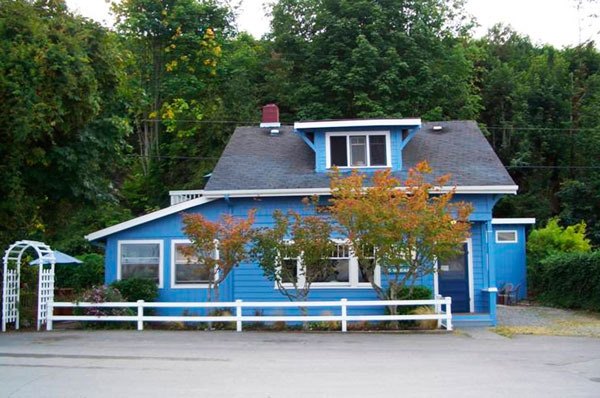The small house at the foot of today’s Wharf Street was first occupied by Phil and Anna Simon beginning in 1910. Its easy access to the new dock Jacob Anthes constructed in 1902 proved ideal for Phil’s pleasure boat business — one of several enterprises he headed.
In addition to captaining his two launches for picnic outings to Hat and Camano islands, Phil owned Whidbey Electric. That business powered Langley street lights and offered residential service two days each week so women could do their washing and ironing. He ran the Sea Breeze Tavern, which transformed into a confectionary during Prohibition that sold candy, soft drinks and tobacco. Phil also served as Whidbey distributor for the Seattle Post Intelligencer and spearheaded development efforts on Langley’s waterfront.
In the early 1900s, the Langley dock buzzed with activity. Mosquito fleet ferries brought passengers from the mainland and other Whidbey stops. Salish natives seined for salmon and sold them to townspeople for two bits, in turn patronizing local merchants with their profits. A berry growers association and an egg co-op operated from the marina. Locals harvested salal and sword fern greens to supply florists nationwide.
It was a heady time for a man as ambitious as Simon, who was particularly popular with young people. Perhaps that was inevitable for the proprietor of a confectionary, but he helped Esther and Claude Furman elope in one of his launches — a gesture that must have endeared him to Langley teens. The city council was not so taken, threatening to reduce Whidbey Electric’s fee if street lights did not remain on from dusk until 11 p.m.
When ferry service to Langley was cancelled in 1929, threatening the town’s economy, Phil organized the Langley Dock Company to revive and develop the area. The company purchased the dock and platted Sunrise Beach. Ten years later, the city assumed responsibility for the wharf and continued revitalizing it with Works Progress Administration money.
Over the years, the Simons had two daughters and a son, enlarging the house to accommodate their growing family. It was this house that Barney Hein purchased in 1959 following Phil’s death. Barney was a city council member, owned a hardware store and, later, a marine supply business at the dock. The house itself, however, languished over the next 20 years until Pat and Bob Drake purchased it in 1985.
Their daughter, Christina, remembers that her father rebuilt the house from the ground up.
“He never did anything small,” she said.
The Drakes lived in the house and rented rooms there from the beginning. Bob began beekeeping and commercial fishing after retiring from an earlier career as a school principal. He was also an original co-owner of Nichols Brothers, helping Frank Nichols construct their boat building works in Freeland. He rounded out his career as a jazz musician, playing Seattle clubs with his Uptown Lowdown Dixie Land Jazz Band.
Christina said that Drake’s Landing hosted “…annual Mardi Gras parties to end all Mardi Gras parties” — flowing from her father’s love of New Orleans music.
Simon and Drake were curiously similar in their enthusiasm for attempting wildly different projects and thinking large. It seems fitting that they both resided in the same home.
Current plans to develop the Langley marina probably will not accommodate the little Simon house, though Phil Simon Park continues to memorialize his contributions to Langley. The hope is that some further recognition of the Simon and Drake families will be incorporated in the development design.


